They Live: Best Conspiracy Film?
Join my friends’ and my new podcast! Tomorrow we feature the gum-chewing, sunglass-wearing Roddy Piper as he breaks through all the conventions of conspiracy films we’ve discussed so far. Don’t miss it.

Join my friends’ and my new podcast! Tomorrow we feature the gum-chewing, sunglass-wearing Roddy Piper as he breaks through all the conventions of conspiracy films we’ve discussed so far. Don’t miss it.

So the devious, sexy spy of North by Northwest, Eve Kendall (Eva Marie Saint), is trying to elude dupe Roger Thornhill (Cary Grant). She gets a secret call from her evil lover, Phillip Vandamm (James Mason), while she and Roger are together and writes down an address for their rendezvous.
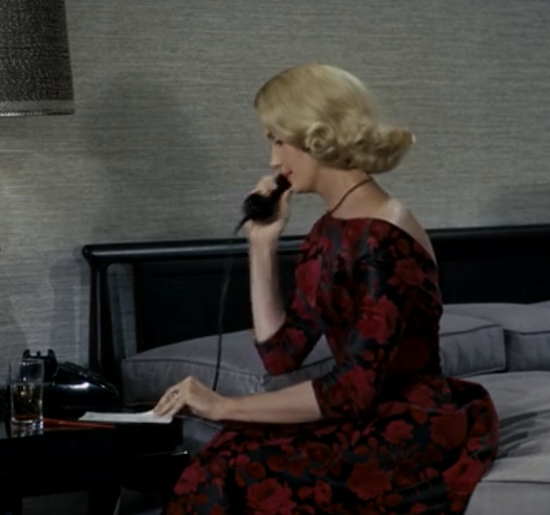
She carefully tears off the paper with the address, places it in her purse, and then—ready for this?—walks away without the notepad.
There’s that notepad, just a pencil trick away from exposing that address. Will she remember to bring it with her? Roger is watching!
Alas. She walks away.
Will she remember before she sneaks away? Of course, right? It was just a momentary oversight, her wits clouded by the sexiness of her target, Roger.
We see her pick up several other things.
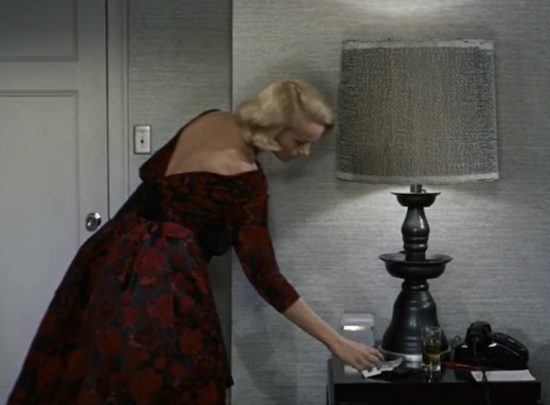
(Oh, that sly Hitchcock.)
Then she leaves the room, SANS NOTEPAD.
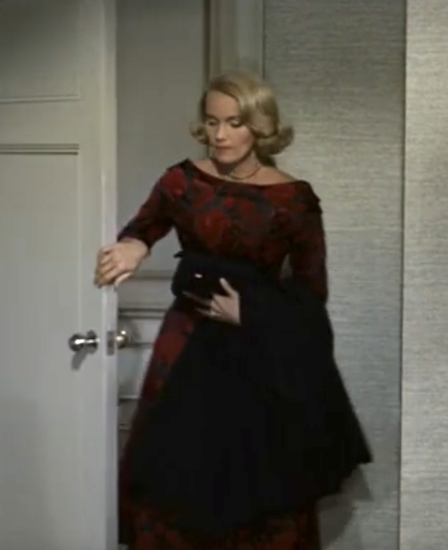
Roger, having watched five minutes of television/film in his life, of course knows the pencil trick. He holds the paper this way and that….(Why? What does he think he’ll see?)
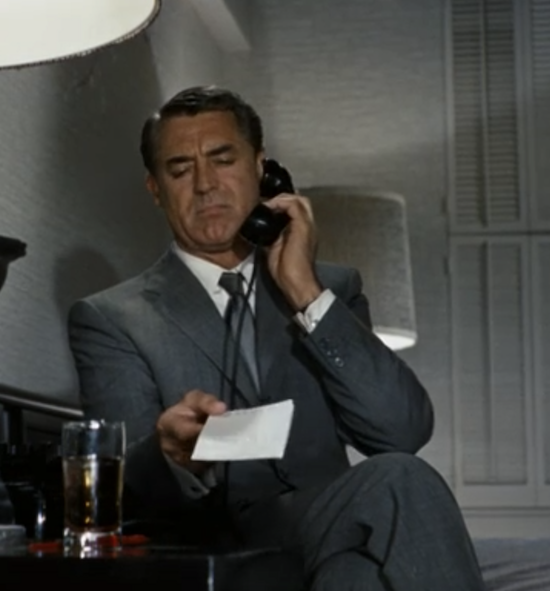
He takes out his pencil. He does the trick pant-less (in a kind gesture of Hitchcock’s, who knows his female fans).
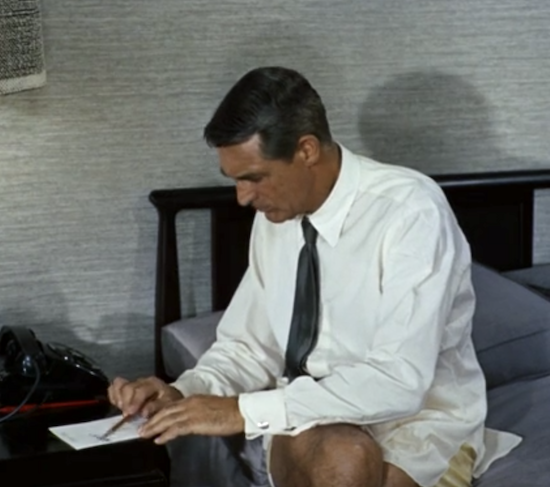
There the address is. The super-secret address Eve was so anxious to hide.
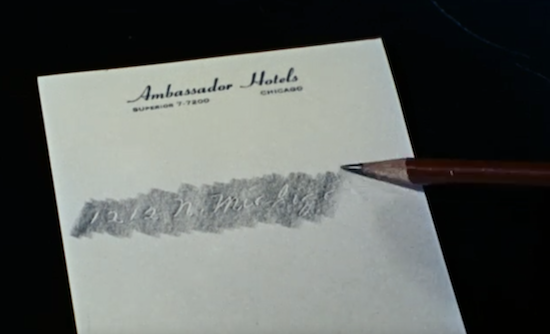
How long have you known this trick? Were you six? Maybe seven? I’m pretty sure Encyclopedia Brown taught me. It’s the kind of spy craft a child can understand and appears in every detective/noir/suspense film or TV episode that assumes its audience is young/dumb/abysmally ignorant of pop culture. Frankly, I would have thought such a plot device beneath Hitchcock. But he never did like giving his heroines much credit, so of course, this spy who has supposedly fooled JAMES MASON must be outsmarted by a different man. Who has a background in….advertising. And lives with his mother.
Yes, our sexy spy was outfoxed by a trick that Micky Mouse might have taught me in the 80s, back when Disney was hawking his image on magic trick books, and I thought that a wand that lifted a playing card with a hidden piece of string was really something.
True, the pencil maneuver wasn’t QUITE as old of a trick when Hitchcock used it, but it wasn’t exactly fresh in 1959. (Though, as my friend points out, today it might become new again, with so few people using pencils.)
I used to roll my eyes when I saw this pencil-and-notepad trick, annoyed by the lazy writing. But now I laugh. Because the Coens offered a send-up of this trite scenario in their—appropriately enough—satire of/tribute to The Big Sleep, The Big Lebowski. The Dude tries to outsmart a villain using the pencil trick. His excitement is intense at his own cleverness. But alas for the Dude, the “secret” isn’t what he expected. If you are of delicate sensibility, I wouldn’t advise it, but if you don’t mind some crude humor, enjoy this film clip and Jeff Bridges’ brilliance in it. (Watch that loopy run of his! And his “just acting natural” look at the end!)
There are many, many jokes about detectives in The Big Lebowksi. One of the most evident is that unlike those brilliant sleuths who with scant clues manage to figure out everything, the Dude can’t figure out anything—the mystery, which people are manipulating him, where his rug is. And unlike the driven fictional detectives who will sacrifice anything for the job, the Dude is pathologically lazy, sharing with them only some loose sense of ethics, questionable associates, and a love for alcohol (but with the Dude, of course, it’s not a hardboiled choice like whisky, but instead White Russians).
Yes, the Dude is not a good detective, and would be an even worse spy. But guess what, Hitchcock?
Even the Dude knows the pencil trick.

I think it was about five minutes into Psych‘s new movie that I realized just how much I was smiling.
How to explain the effects of Psych? It’s my emotional yoga. When I can’t sleep, I lie on the couch and play episodes till I do. It’s my white noise when I’m doing mindless busy work. And when I really need a pick-me-up (and who doesn’t right now?), I can put on an episode–even my least favorite–and laugh so much. (This despite the fact that I’m surely close to having the whole show memorized by now.) It doesn’t matter if I’m sad, worried, stressed; Psych‘s hilarious dialogue and antics always makes me smile. And the movies are no exception.
Lassie Come Home is both a typical episode and a tribute to Timothy Omundson (Lassie), whose stroke prevented his full participation in Psych: The Movie. But sweet as the tribute to Lassie is, it’s the Shawn and Gus team-up that’s the highlight, as always. I could listen to them banter all day long. This is still the best bromance I’ve seen on TV.
A favorite moment is when Shawn and Gus are trying to get a man to admit he’s faking an illness by tickling him. Shawn (James Roday Rodriguez) begins the badgering of the man like this: “Tough guy from the old neighborhood. Probably didn’t even cry when Liz Berkley got addicted to speed in Saved by the Bell.“
Now that’s a pop culture reference!
As usual, there were some funny cameos, with Sarah Chalke, Scrubs alum, directly referencing her scrubs, and Kadeem Harison from A Different World showing up, reminding fans that Dwayne Wayne was Gus’s (Dulé Hill) early hero (see that bizarre werewolf episode, “Let’s Get Hairy”–Season 4, Episode 8). Chalke was an inspired addition–she fits right in. My other favorite new character was Morrissey, Chief Vick’s (Kirsten Nelson) dog. And current fan or not, you will love a wonderful breaking the third wall moment, when Shawn refers to Psych fans (Psychos), and Gus rips him in response.
Way back when I started this blog, I recommended The Thin Man to Psych fans. But that recommendation goes both ways. Are you a fan of delicious flavor–i.e., funny dialogue? Do you love pop culture references? Do you prefer the relationship between detectives (and their loved ones) to the mystery itself? Do you enjoy some childishness in your leads, as long as it’s funny? (If you’ve forgotten how immature Nick Charles is, watch his classic performance at his in-law’s house in After the Thin Man.)
If you share my preferences, why are you waiting to watch the series, much less Lassie Come Home? I envy you the eight seasons and three films (if you include the musical) you have yet to watch! And if you’re already a Psych fan, you’ll be so happy to have Shawn and Gus back–even for a little while.
PBS produced a new documentary on my favorite movie wordsmith and feminist rebel, Mae West. Dirty Blonde is coming. Check out the preview to see the subjects talking about her (some welcome surprises), and to hear some of your favorite Mae West quips.
I can’t wait! Check it out on June 16 at 8/7c on PBS and on their site.
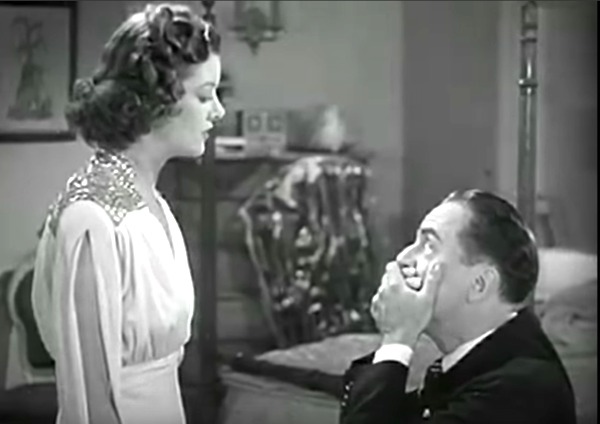
It’s not unusual to find a film with a strikingly ridiculous plot. I spent many Friday nights as a teen watching USA Up All Night (hosted by Gilbert Godfrey). How I loved taking in gloriously dumb films, hour after hour.
But to find movies with such plots that are genuinely good? That’s a whole other level of enjoyment. Now add 80 years or so, and the film is STILL GOOD, STILL FUNNY? That’s a comedic masterpiece.
Last Tuesday I wrote a post on feel-good silly films, and rated them according to their degree of silliness. (In a homage to Spinal Tap, I let the ratings go to eleven rather than ten.) So today, I’m going to list five films with plots so absurd they deserve that 11 silliness quotient fully. And not coincidentally, these films are a blast to watch. In no particular order:
The Palm Beach Story (1942)
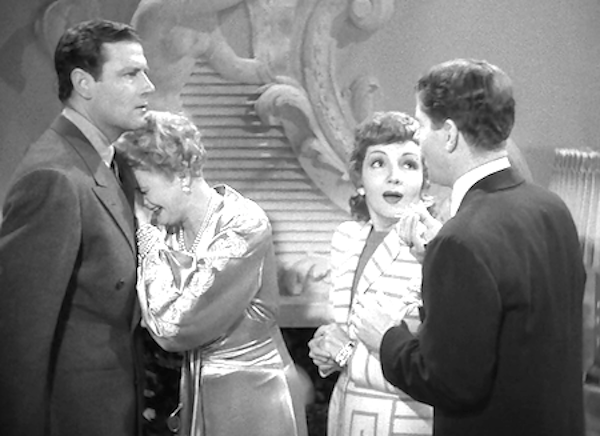
A woman (Claudette Colbert) leaves her broke husband (Joel McCrea) so that she can marry a millionaire and use his money to fund her original husband’s brilliant project. She heads to Palm Beach to find such a millionaire, aided by a “wiener king ” and trigger-happy hunters. The writer/director is Preston Sturges, so you know you’re in for a treat.
Easy Living (1937)
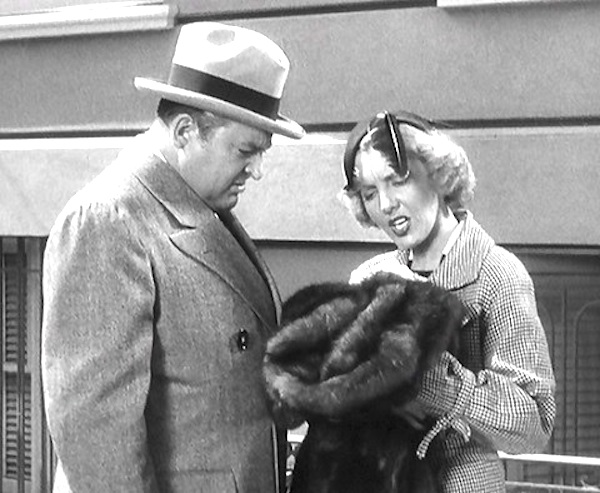
A banker (Edward Arnold) in a fight with his extravagant wife (Mary Nash) throws her fur coat off the roof of their home. The coat hits the hat of a bus passenger (Jean Arthur). The banker’s attempts to compensate the passenger destroy her reputation, but do aid her income. If you need a teaser to be convinced, check out the banker’s and passenger’s hilarious fight about loan interest.
Arsenic and Old Lace (1944)
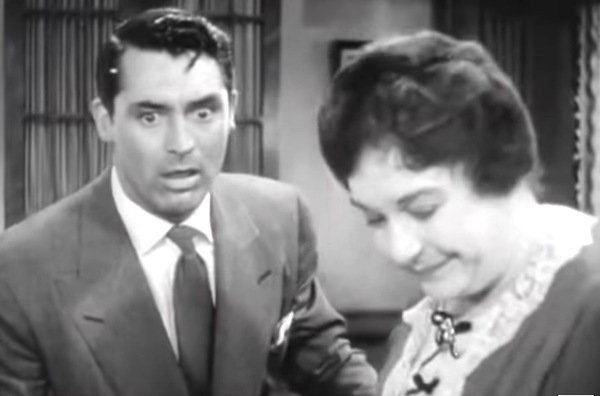
Mortimer (Cary Grant) has always known his cousin (John Alexander) is a bit off. After all, his cousin thinks and acts like Teddy Roosevelt, building his canal. But in visiting his beloved aunts (Josephine Hull and Jean Adair), Mortimer discovers they have some issues as well: they’re serial killers murdering lonely old men. “Teddy” assumes the dead bodies are yellow fever victims and takes them in stride. But Mortimer begins to fear for his DNA. A screwball classic.
I’m No Angel (1933)
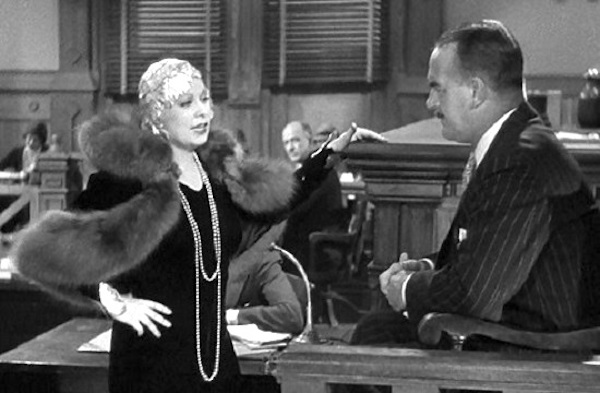
A lion tamer (Mae West) becomes the talk of high society, even winning a classy lover who plans to marry her (Cary Grant). The circus fears losing her income, so they convince the lover that their star is cheating on him. When her lover leaves her, the tamer sues him for breach of promise. She acts as her own lawyer, spending 90 percent of the trial strutting and seducing the jury in what may be the funniest courtroom scene ever.
I Love You Again (1940)
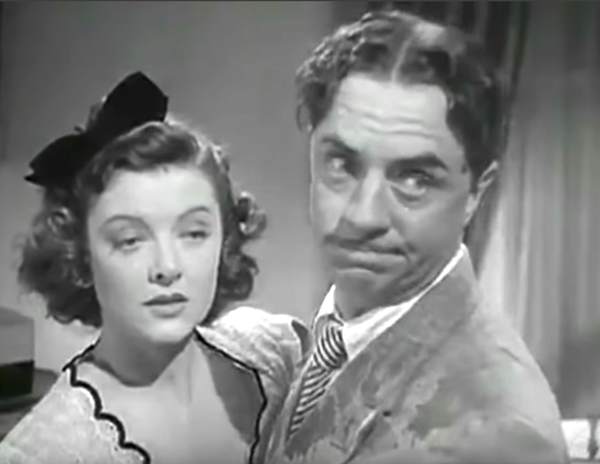
A man (William Powell) gets hit on the head and becomes an old self he’s forgotten, a swindler, instead of the upright prude he now is. He decides to live the prude’s life as he looks for a score and becomes intrigued by the uptight man’s wife (Myrna Loy), whom the swindler version of himself never met. She, sick of his stodgy ways and unaware of his change, wants to divorce him. The question is, will the man’s wife fall in love with his older self? I feel dizzy just explaining this amnesia plot, but it’s The Thin Man’s Loy and Powell team, so what’s not to love?
There you have it. Five ridiculous plots. Five ridiculously fun movies. And I haven’t even scratched the surface of this topic! Anyone who wants to share their favorite silly plot, please do so in the comments!
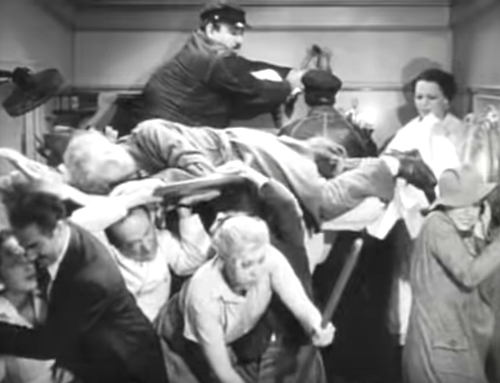
As the pandemic length has grown and your patience has seeped away, what spells a “comfort” movie to you may have changed. If you’re single and alone, the rom-com, usually a fallback, may make you cringe about the horror of dating dangers post-opening (as if dating usually weren’t bad enough!) If you’re huddled inside with TOO MANY PEOPLE, you may find yourself enjoying dull footage of peaceful lakes.
But for all of us in times of stress, the truly, deeply silly movie remains a staple, and so in the long-delayed follow-up to my earlier post, “Classic Feel-Good Movies for Shut-Ins,” I’m going full-on silly with my next set of suggestions. I’m joining my peers at the Classic Movie Blog Association, who are sponsoring a great blogathon event on comfy favorites. So here are five comfy classic films, chosen for silliness and enjoyment–and listed in no particular order. (You will note that I’ve rated the silliness level, so not all here are full madcap in style. BUT I’m thinking that a list of films with silliness at level eleven, and eleven only, may be my next project.)
5. The Miracle of Morgan’s Creek (1943/4). Silliness Quotient–11 out of 10.
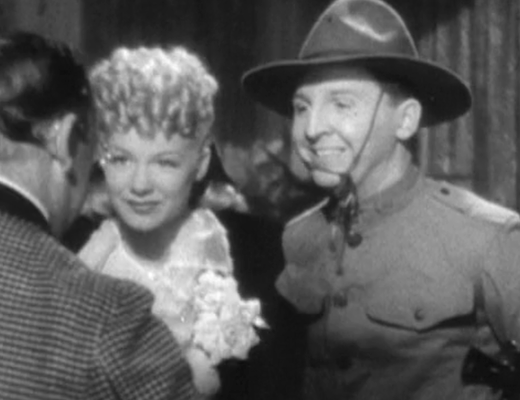
I could have easily chosen ANY Preston Sturges flick obviously, but I recently discovered this on my library’s Kanopy streaming service, and just seeing the listing made me grin. For those of you who DON’T know writer/director Sturges, he was a big Coen brothers influence, thus the name of their film, O Brother, Where Art Thou?, a reference to Sturges’ classic, Sullivan’s Travels. (In fact, the Coens’ film title ONLY makes sense if you have see the Sturges flick.) This early writer/director’s delirious combination of madcap physical comedy, witty banter, and sheer improbability in his plotting make Sturges a favorite of any Coen brothers’ diehards (which I definitely am).
The Miracle of Morgan’s Creek actually thrives on denying information to its audience, who know that a scandal/miracle is about to erupt in Morgan’s Creek, and many stratagems are in play to contain it. Betty Hutton is adorable as the center of the scandal, and Eddie Bracken plays her lovesick friend/maybe-more (think Ducky in Pretty in Pink). Basically, it all begins when Hutton has too good of a night with liquor and a bunch of soldiers and sleeps with one of them. The thing is, she can’t remember his name. Yes, you read that right. It gets much more complicated as it goes. Bracken has the silliest role, and he captures his character’s constant befuddlement to the hilt—and just escapes going too far. Since the writing is in Sturges’ hands, it’s brilliant, of course (I have a set of his scripts on my bookshelf, trying to see how he does it).
4. Auntie Mame (1958). Silliness Quotient–7 /10.
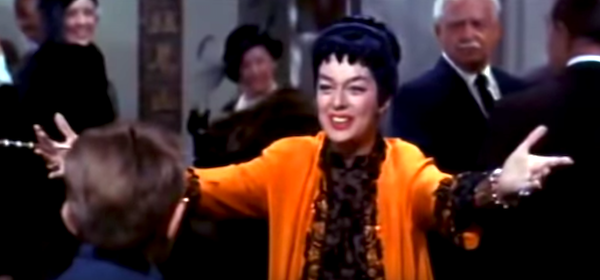
I haven’t yet done a full post on Auntie Mame, but that’s because I love it too much, not too little. An unconventional, fun-loving aunt in the city (Rosalind Russell) takes in her dead brother’s prim child, and many hilarious scenes ensue. If you don’t end the film wishing Auntie Mame were your aunt, I don’t know what’s wrong with you. Rosalind Russell’s acerbic edge keeps the film from ever treading into maudlin territory, and she so fully embodies Mame’s significant lust for life that it’s very confusing to find Russell cowed and sad in other films (Picnic, for example).
A favorite scene in the film is when Mame takes a sales job after the market crash. She only knows how to do COD (cash on delivery), and therefore is urging everyone to pay that way. Her dismay when they don’t is ALL OF US in every job when we’re out of our depth. COD isn’t really a thing you hear much anymore, but any time I do hear it, I think, “Oh, Mame.”
3. The Man Who Came to Dinner (1942). Silliness Quotient–7/10.
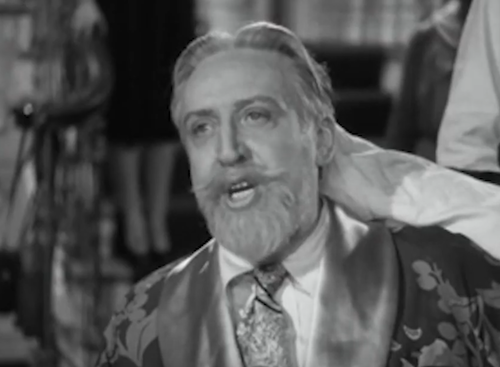
“Guests, like fish,” penned Ben Franklin, “begin to smell after three days.” No movie has ever captured that sentiment better than The Man Who Came to Dinner, and no actor has ever improved on Monty Woolley’s commanding performance of entitlement personified. He’s playing radio star/personality Sheridan Whiteside on a lecture tour, and the unlucky family once so proud of his appearance at their dinner table learns to rue the day they agreed to it. A little accident on their stoop, and they’re stuck waiting hand and foot on Whiteside’s prodigious ego.
George S. Kaufman and Moss Hart created the witty script, and Billie Burke plays the unwilling hostess to Whiteside. (Bette Davis may have helped the film get made, but her role here is one of her most flavorless. You know it’s not a Davis vehicle when Ann Sheridan outshines her.) Watch the film for the script and for brilliant Woolley, who must have been something to see on the stage (where he originated the role). Unfortunately, I have delayed writing about this film because it seems to be always unavailable for streaming on Amazon, but the DVD is available. If you know a good source for streaming it, please mention that in the comments!
2. Ball of Fire (1941). Silliness Quotient–7/10.
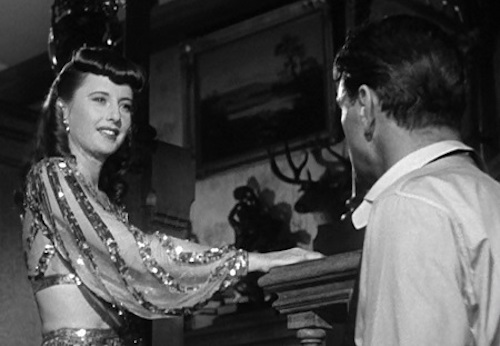
No list of silly movies would be complete without my favorite classic comedy, with Barbara Stanywck as the moll and Gary Cooper as the hapless encyclopedia writer who falls for her. And then there are the “dwarves”–the older encyclopedia writers who ALSO fall for her. I see that the film’s available on the Criterion Channel, which I’m shocked I don’t belong to yet. (No worries for me–I own two DVDs of this movie–the 2nd for when mine inevitably breaks from overviewing.)
With the dizzyingly talented combination of Howard Hawks as director and Charles Brackett and Billy Wilder as writers, this film’s dialogue can be almost as breathtaking as His Girl Friday‘s (also Hawks), but the writing/directing team leaves room for endearingly slow sequences as well. You actually watch Cooper’s character studying how to box in a book before his big fight scene, showing how goofy this story is. And for extra fun, you get favorites Dana Andrews, Dan Duryea, and S.Z. Sakall simultaneously embracing and mocking their typical roles.
1. A Night at the Opera (1935). Silliness Quotient–11/10.
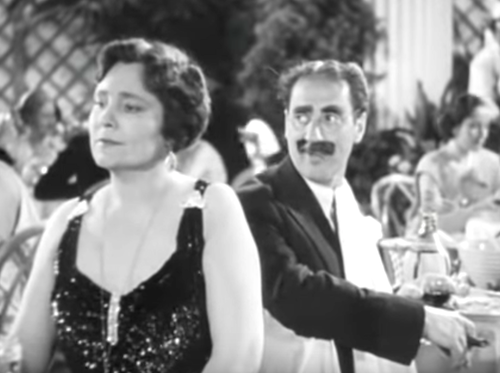
Did you honestly think you’d get through this list without a Marx brothers appearance? I didn’t think so. (As with The Man Who Came to Dinner, the screenplay is co-written by Pulitzer-Prize-winning Kaufman.)
Here are just a few quick early bites: We get Otis B. Driftwood (Groucho) yelling at his driver for not traveling slowly enough to miss the whole opera they’ve driven to see. We have Fiorello (Chico) and Otis tearing apart the bits of a contract they don’t understand (i.e., all of it). We have Tomasso (Harpo) interrupting a typical movie romance trope (one lover onshore, the other on the ship, crooning about her love) by attack-kissing strangers for no reason. That’s just a small sampling of the joys you get before the glorious comedy of the ocean voyage, which includes such a monstrously over-the-top buffet that I wondered just how old the joke about gaining weight on cruises was….
During a strange but enchanting musical sequence starring Chico and Harpo, the two entertain a crowd of children with a deft combo of lunacy and calm, making me think, “Doesn’t every parent stuck at home with children for weeks want these two as babysitters right now?”
So there you have it–five wonderful, comforting films to get you through this trying time. NOTE: You may notice that neither Mae West nor Cary Grant has appeared on this list. That’s because 1. I already discussed Mae in my previous comfort list, and 2. I figured you’d already thought of Cary–and if you haven’t, why not?
Bonus: Kedi (2016).

I know–it’s not a classic film. It’s a recent documentary about the cats of Istanbul. But I have literally recommended it to every cat lover I know, and when I found it streaming on my library’s Kanopy service, played it on repeat for a day. The film focuses on several stray cats, telling their stories (the hunter, the crazy one, the player, etc.). The cats are certainly endearing, but surprisingly, the shopkeepers, artists, and others who love and care for them are just as likeable. And the cinematography of Istanbul is often gasp worthy, especially when you see those cats on some tall balconies and rooftops! My friend described the film as human catnip. How right she is. Next time you experience one of those anger/grief/anxiety spirals that all of us are prone to during this pandemic, play Kedi. Trust me. It’s healing.
This post is part of the Classic Movie Blog Association’s Classics for Comfort blogathon, so you can find many more suggestions on feel-good films there if mine don’t meet your needs—or, which is even more likely, you need more. Enjoy!
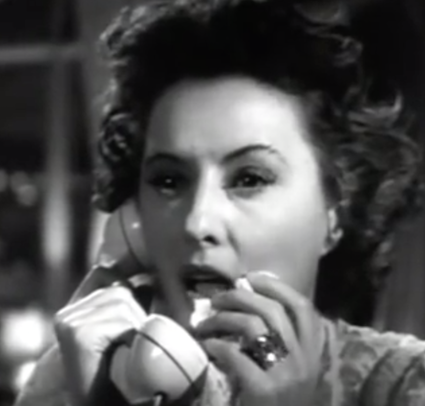
My friend Grace Collins of True Stories of Tinseltown and I chat about women in peril in classic films, including the riveting thriller Gaslight; the Barbara Stanwyck showcase Sorry, Wrong Number; and the tonally inconsistent, oddball Nazi-hunter film, The Stranger. And of course, the weeper, Waterloo Bridge. We had so much fun talking about heroines who are having no fun at all–especially Mary (Loretta Young in The Stranger), whose affection for her mate is truly baffling.
Check out the podcast on her site and on podbean.
Enjoy Grace’s other wonderful posts and podcasts on her sites or check out her Facebook page for more. Her summer series on famous blondes in film is fabulous, especially the one on Mae West.
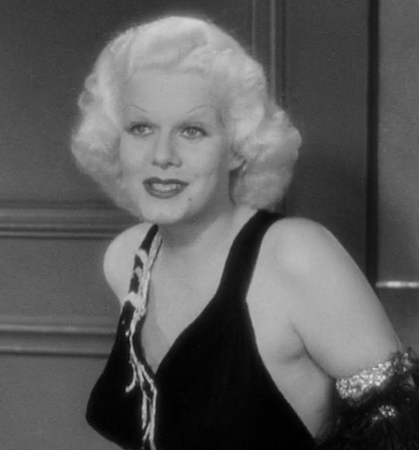
I’ve been thinking about how hard it is to grieve the loss of a funny person. The grim process of American funerals—the still church/mortuary, the solemn rituals, and the steady tears—can feel inappropriate when mourning the loss of someone who enjoyed breaking conventions, who made you bend over laughing when you were supposed to be acting with decorum.
I attended two parties recently to celebrate the lives of such funny individuals, complete with amusing anecdotes and the shared company of those who’d loved them. These memorials felt so fitting, so much better than typical funerals for such amusing personalities, that I returned to my home thinking of other lost comedians and comediennes, especially those whose lives are so often described with the “funny but died tragically” designation. And it struck me that Jean Harlow was someone who deserved the kind of festive send-off I’d just attended, a woman who relished breaking the rules of others on and off screen (especially prim others) in such a breathtakingly funny way. So I watched The Girl from Missouri (1934), the lesser known of two entertaining gold digger tributes originally penned by Anita Loos, to celebrate her.
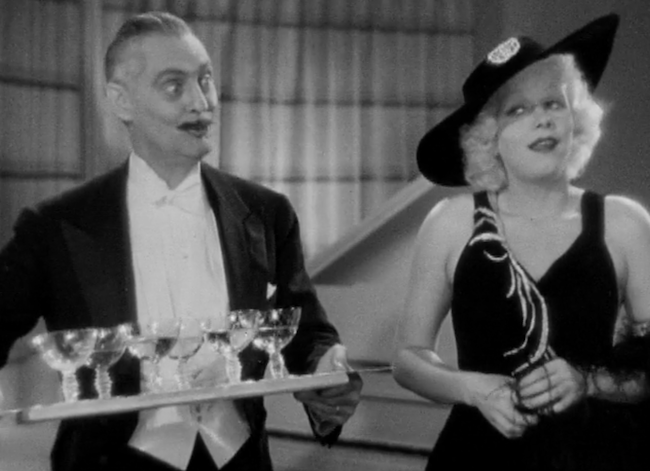
Harlow stars as Edith Chapman, a young woman eager to escape the clutches of the family entertainment/bar business, which is full of men trying to keep her from staying “straight.” Marriage to a millionaire in New York is her plan, and she won’t have sex until she gets her goal, which she brazenly sets about doing. Her very transparent efforts first amuse, then mildly annoy the wealthy self-made businessman, Thomas Paige (Lionel Barrymore)—that is, until her attention turns to his son, Thomas Paige, Jr. (Franchot Tone). Paige Sr. wants Junior to be courted by the upper-crust society he aspires to join, not for his progeny to be dismissed as the target of a silly gold digger. Predictably, Papa Paige is soon plotting against Edith. But she, like the actress who brought her to life, doesn’t take that kind of treatment passively….
Like many of Harlow’s characters, Edith is goofy and blatant and oblivious to any kind of etiquette or class mores. But there’s something about Harlow…you just can’t dismiss her characters. (And you can’t pay attention to anyone else—a Barrymore, Clark Gable, Spencer Tracy, even a Powell/Loy combo—when she’s onscreen.) Her characters usually dress in frilly, showy clothes, and their words and actions are designed for punch lines at their expense. Yet the deep humanity, sincerity, daring, and lovability of Harlow’s heroines make you adore them all the same, root for them even when they don’t deserve it (i.e., Red-Headed Woman).
And Edith deserves fair treatment and compassion. She even manages to make a Franchot Tone playboy character palatable to me. Edith begs Paige, Jr. not to toy with her, confesses that he could make her sacrifice the virtue she’s worked so hard to protect, but pleads that he let her go instead.
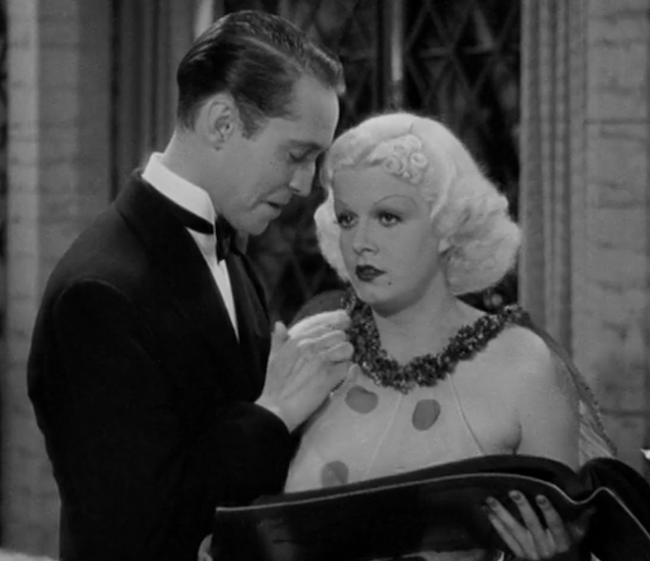
Paige, Jr.’s reversal of expression, his contrite response to her words is really all of us: Don’t take this awesome woman for granted. We won’t have her for very long.
I didn’t expect to catch my breath and feel for a Harlow character’s pain, but The Girl from Missouri caught me offguard, and that made me smile. Wow, Harlow can get to me. I did expect to laugh often as I watched, and of course I did. There are some cute turns by others–Paige Sr.’s teasing, Edith’s sex-obsessed sidekick’s (Patsy Kelly’s) flirtations. But why pay attention to anyone else? Harlow is MARVELOUS—with every preening smile, with every stomp/bustle, with every huff (and huffs there are a-plenty with Harlow), you can’t stop smiling. And you can’t stop thinking, What a joy it is to be in her company. I’ll take every second I can get.
And so I laughed. And expressed a silent thank you for the gifts she’d given me. And that, to me, was the perfect send-off.
**Spoilers abound**
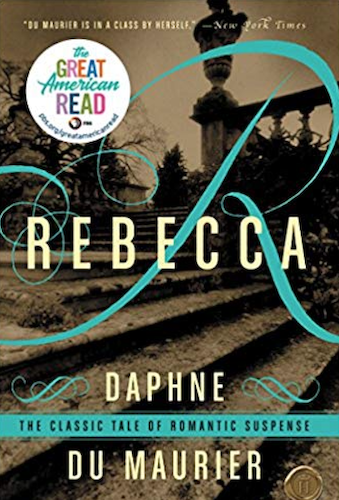
Of all the femme fatales on film and in print, Rebecca may top them all. The woman isn’t even alive at the start of the book or the Hitchcock film that resulted from it, yet the narrator of the story is so haunted by her husband’s previous wife (and Du Maurier is so skilled at freaking readers out) that Rebecca’s reputation as the evil femme fatale endures.
But when we look at Rebecca’s life a little closer, it’s hard to ignore just how much of our impressions of this woman are based on her former husband’s hatred and his second wife’s jealousy. Although I was totally with the narrator in fearing and loathing Rebecca on my first reading of Daphne Du Maurier’s classic gothic novel/thriller/mystery, my opinion of Rebecca has radically shifted in time, and the blame moved from her to the much more questionable Max de Winter.
Since the film sanitizes the hero due to the Production Code, I’m sticking with the book as I ask all of you Du Maurier lovers this question: Who is worse, Rebecca or her husband Max?
Let’s count it down trait by trait, shall we?
Behavior toward Friends & Acquaintances. Rebecca. Tries to suit others’ moods and appeal to their interests—this according to her detractor, Max. Everyone loves her, Maxim admits, including all of her employees. He claims she is fake, a backstabber. It’s easy to discount the tales of her insincerity altogether, given those blunt admissions to Max at the start of their marriage and his own dubious motives in smearing her. But we do hear Ben describing her cruelty toward him, a serious count against her.
Max: Rude to and arrogant toward: his sister, his brother-in-law, attorneys, party guests, servants, Mrs. Van Hopper, his second wife. He does seem to usually treat Frank well, and perhaps the dog. He expects to be thought above the law despite his suspicious actions and has no compunction about the boat maker’s profit losses thanks to his lies. Why? Presumably his class and status.
Personality Points: Rebecca 1; Max 0
Villain Points: Max 1; Rebecca 1
Social Skills. Max is the very definition of prim, spending his days abstaining from most people and food (while strangely expecting an untouched feast on a daily basis). And, there’s that slight issue with his temper and moods. Good company? I think not.
Rebecca’s style intimidates the narrator; she has garnered Manderley fame with her exquisite taste and the elegance, creativity, and humor she exhibits as a hostess. Even the “R” of her name is written with panache.
Personality Points: Rebecca: 1; Max: 0
Treatment of Spouse. Let’s admit from the start that these two are hardly an altruistic pair. A tight race!
Max: Wife 1. Marries Rebecca without loving her but planning to be faithful. Keeps the secret of her affairs, but for his own pride. Does tolerate her behavior within limits. (It was a different age.) Seemingly polite to her in public but based on his general actions (see above), I’m guessing she needed to find affection elsewhere. Wife 2. Marries the narrator because she’s chaste and has no relatives (Mrs. Van Hopper isn’t far wrong there). Shows little passion for her, most of that passion being extended to his house. Treats her like a daughter/servant/enemy, depending on the day. Marries her knowing that his limelight-averse spouse will be destroyed if his crime is revealed and the scandal rags come a-knocking while her protector is in jail. Exposes her to Mrs. Danvers, the suicide pusher.
Rebecca: Marries Max for his money and status, planning to cheat on him from the start and admitting as much. Seemingly has multiple affairs. Apparently enjoys some “unspeakable” behavior (though given prim Max’s ways, I’m guessing we’re not talking Roman orgies). May, if the love of Mrs. Danvers is any indication, indulge in affairs with women as well as men, which in this time period would have harmed her husband’s reputation. Shaming her husband with alcohol and drug consumption? Perhaps in private. Meanwhile, spends her days being delightful to all and making his treasured house the talk of the country.
I’m going to leave out Max’s crime for this one, as it deserves its own category. But in terms of behavior up to their final night together, Rebecca’s is worse since Max’s biggest fear is public shame, and she doesn’t seem to care much that he’s a bore and has no fidelity impulses/regard for his pride whatsoever. However, his behavior to his second wife is appalling.
Villain Points: Rebecca 1; Max 1
The Murder. Max shot his wife because she suggested she might be pregnant with another man’s baby. Max demonizes her, calling her not even “human,” to (a) justify his action, (b) keep his wife’s love, and (c) be considered a civilized member of society. The narrator, so pleased he didn’t ever love Rebecca, actually goes along with his version of events, even though he’s not exactly trustworthy because he’s a killer who murdered his last wife, idiot. RUN!!!!
Rebecca. Enjoys her husband’s distress at her infidelity and taunts him. He now says she wanted him to kill her (given her health). Kinda convenient, right?
Personality Points: Rebecca, 1—some considerable moxie revealed in this last fight; Max, 0. Villain Points: Max, a gazillion; Rebecca, 0.
And the Verdict Is….
Personality Points: Rebecca 3; Max 0
Villain Points: Max, a gazillion and 2; Rebecca, 1.
Like I said, Rebecca might not be an angel, but a femme fatale? Not so much. And is Max, the cold-blooded murderer and awful husband a homme fatale? You better believe it.
This post is part of the Calls of Cornwall blogathon by Pale Writer on Du Maurier’s work. Check out the other entries!
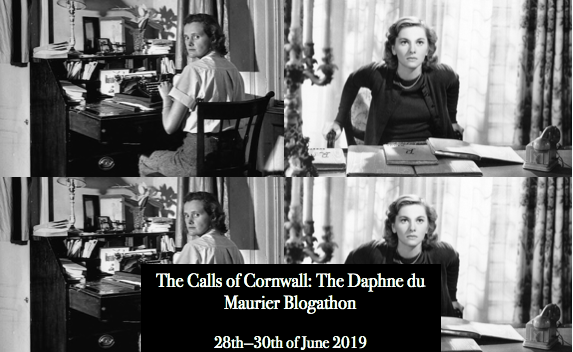
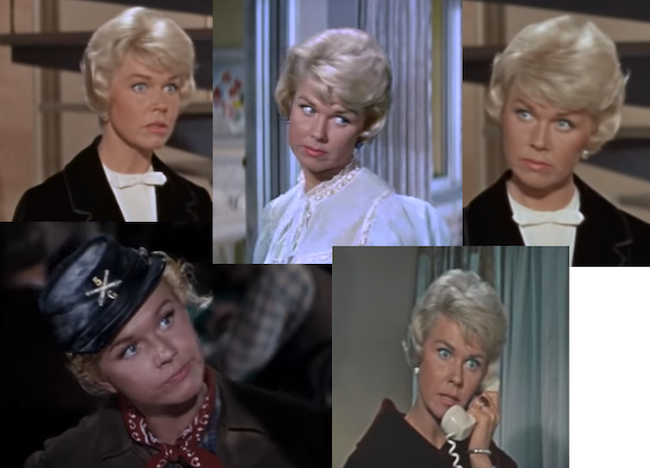
Today a man I know well surprised me, and I could tell I had one of those hilariously odd expressions on my face in response. When I heard a couple hours later that Doris Day had died, it seemed to me that I’d inadvertently paid tribute to that marvelous, strong, very funny woman. There will never be anyone who has a more entertaining or endearing response to male oddities than Doris Day. So today I want to say how lucky we are–among many, many gifts she gave us–for the hilarious reaction shots only she could deliver. Whether disdainful, amused, outraged–or best of all, all three–Day’s expression just nailed a sentiment….And so today, Doris, this feminist sends her heartfelt thank you. I couldn’t have said it better.